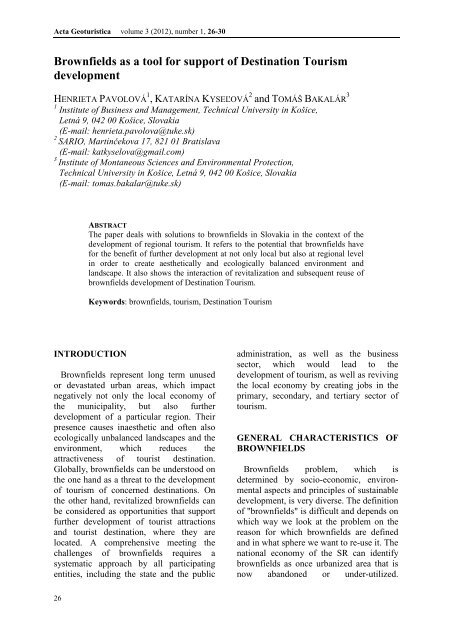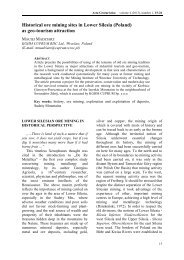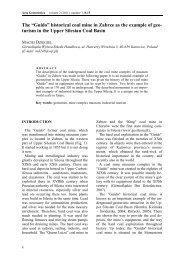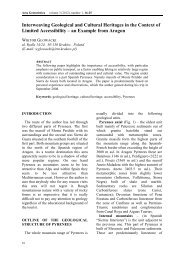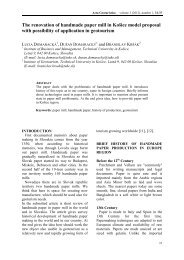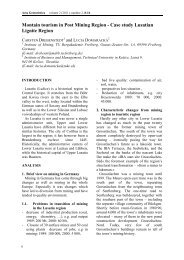Brownfields as a tool for support of Destination ... - Acta Geoturistica
Brownfields as a tool for support of Destination ... - Acta Geoturistica
Brownfields as a tool for support of Destination ... - Acta Geoturistica
Create successful ePaper yourself
Turn your PDF publications into a flip-book with our unique Google optimized e-Paper software.
<strong>Acta</strong> <strong>Geoturistica</strong> volume 3 (2012), number 1, 26-30<br />
<strong>Brownfields</strong> <strong>as</strong> a <strong>tool</strong> <strong>for</strong> <strong>support</strong> <strong>of</strong> <strong>Destination</strong> Tourism<br />
development<br />
HENRIETA PAVOLOVÁ 1 , KATARÍNA KYSEĽOVÁ 2 and TOMÁŠ BAKALÁR 3<br />
1 Institute <strong>of</strong> Business and Management, Technical University in Košice,<br />
Letná 9, 042 00 Košice, Slovakia<br />
(E-mail: henrieta.pavolova@tuke.sk)<br />
2<br />
SARIO, Martinčekova 17, 821 01 Bratislava<br />
(E-mail: katkyselova@gmail.com)<br />
3<br />
Institute <strong>of</strong> Montaneous Sciences and Environmental Protection,<br />
Technical University in Košice, Letná 9, 042 00 Košice, Slovakia<br />
(E-mail: tom<strong>as</strong>.bakalar@tuke.sk)<br />
ABSTRACT<br />
The paper deals with solutions to brownfields in Slovakia in the context <strong>of</strong> the<br />
development <strong>of</strong> regional tourism. It refers to the potential that brownfields have<br />
<strong>for</strong> the benefit <strong>of</strong> further development at not only local but also at regional level<br />
in order to create aesthetically and ecologically balanced environment and<br />
landscape. It also shows the interaction <strong>of</strong> revitalization and subsequent reuse <strong>of</strong><br />
brownfields development <strong>of</strong> <strong>Destination</strong> Tourism.<br />
Keywords: brownfields, tourism, <strong>Destination</strong> Tourism<br />
INTRODUCTION<br />
<strong>Brownfields</strong> represent long term unused<br />
or dev<strong>as</strong>tated urban are<strong>as</strong>, which impact<br />
negatively not only the local economy <strong>of</strong><br />
the municipality, but also further<br />
development <strong>of</strong> a particular region. Their<br />
presence causes inaesthetic and <strong>of</strong>ten also<br />
ecologically unbalanced landscapes and the<br />
environment, which reduces the<br />
attractiveness <strong>of</strong> tourist destination.<br />
Globally, brownfields can be understood on<br />
the one hand <strong>as</strong> a threat to the development<br />
<strong>of</strong> tourism <strong>of</strong> concerned destinations. On<br />
the other hand, revitalized brownfields can<br />
be considered <strong>as</strong> opportunities that <strong>support</strong><br />
further development <strong>of</strong> tourist attractions<br />
and tourist destination, where they are<br />
located. A comprehensive meeting the<br />
challenges <strong>of</strong> brownfields requires a<br />
systematic approach by all participating<br />
entities, including the state and the public<br />
administration, <strong>as</strong> well <strong>as</strong> the business<br />
sector, which would lead to the<br />
development <strong>of</strong> tourism, <strong>as</strong> well <strong>as</strong> reviving<br />
the local economy by creating jobs in the<br />
primary, secondary, and tertiary sector <strong>of</strong><br />
tourism.<br />
GENERAL CHARACTERISTICS OF<br />
BROWNFIELDS<br />
<strong>Brownfields</strong> problem, which is<br />
determined by socio-economic, environmental<br />
<strong>as</strong>pects and principles <strong>of</strong> sustainable<br />
development, is very diverse. The definition<br />
<strong>of</strong> "brownfields" is difficult and depends on<br />
which way we look at the problem on the<br />
re<strong>as</strong>on <strong>for</strong> which brownfields are defined<br />
and in what sphere we want to re-use it. The<br />
national economy <strong>of</strong> the SR can identify<br />
brownfields <strong>as</strong> once urbanized area that is<br />
now abandoned or under-utilized.<br />
26
<strong>Acta</strong> <strong>Geoturistica</strong> volume 3 (2012), number 1, 26-30<br />
<strong>Brownfields</strong> arose <strong>as</strong> a secondary<br />
consequence <strong>of</strong> industrial restructuring or<br />
other land use, i. e. due to economic and<br />
social changes <strong>of</strong>ten accompanied by<br />
extreme stress in the <strong>for</strong>m <strong>of</strong><br />
semidev<strong>as</strong>tated production and<br />
administrative buildings, remnants <strong>of</strong><br />
industrial operations, contaminated<br />
environment, and so on. From a global<br />
perspective we can consider <strong>as</strong> brownfields<br />
old, unused or economically insufficiently<br />
effectively used industrial and logistics<br />
are<strong>as</strong>, commercial and residential buildings<br />
in compactly built-up are<strong>as</strong>, <strong>as</strong> well <strong>as</strong><br />
agricultural, military and other are<strong>as</strong> and<br />
buildings in the open country. It should be<br />
noted that brownfields arise in any country<br />
and at any time. The experience <strong>of</strong> several<br />
experts, who are dedicated to addressing the<br />
issue <strong>of</strong> brownfields, shows that in these<br />
are<strong>as</strong> gradual decre<strong>as</strong>e <strong>of</strong> employment,<br />
decre<strong>as</strong>ed use <strong>of</strong> property and infr<strong>as</strong>tructure<br />
occur. Additionally, unclean and neglected<br />
land represent also a danger <strong>of</strong> injury to<br />
potential visitors, threaten groundwater and<br />
can be a source <strong>of</strong> contamination spread to<br />
other sites that can be used <strong>for</strong> other<br />
purposes.<br />
In the event that this area will be used<br />
again, it will bring benefits, in the <strong>for</strong>m <strong>of</strong><br />
improved environmental and landscape,<br />
new jobs, new income <strong>of</strong> the municipality,<br />
but also a better image <strong>of</strong> the region.<br />
IMPACT AND CHANCES FOR USE<br />
OF BROWNFIELDS IN THE<br />
DEVELOPMENT OF DESTINATION<br />
TOURISM<br />
<strong>Destination</strong> <strong>of</strong> tourism represents "target<br />
area in a particular region, which is<br />
characterized by a significant <strong>of</strong>fer <strong>of</strong><br />
attractions and tourism infr<strong>as</strong>tructure." In<br />
general, there<strong>for</strong>e, we can say that the<br />
tourist destination is quite natural with<br />
unique properties that distinguish it from<br />
other destinations. <strong>Destination</strong>, <strong>as</strong> its own<br />
product and thus the competitive unit <strong>of</strong><br />
tourism represents a system composed <strong>of</strong><br />
individual service providers (accommodation,<br />
catering, sports facilities, etc.)<br />
influenced by the surroundings in which it<br />
operates (political, economic, social and<br />
natural environment) and thus represents<br />
common [1]:<br />
a/ vision <strong>of</strong> the development <strong>of</strong> destination,<br />
b/ concept <strong>of</strong> tourism,<br />
c/ creation <strong>of</strong> menus,<br />
d/ marketing strategy.<br />
<strong>Brownfields</strong> are <strong>of</strong>ten located in attractive<br />
tourist destinations in the interaction with<br />
primary, secondary, but also tertiary sector<br />
<strong>of</strong> tourism. <strong>Brownfields</strong> in many c<strong>as</strong>es are<br />
part <strong>of</strong> cultural heritage (cultural,<br />
montaneous, and technical monuments).<br />
They are located near urban centers or<br />
major infr<strong>as</strong>tructure networks. In addition,<br />
the land on which the brownfields are<br />
located, always need the same or higher<br />
costs even though it brings considerably<br />
less benefits. In addition, they significantly<br />
reduce the value and image <strong>of</strong> the<br />
surrounding land in a tourist destination.<br />
This decre<strong>as</strong>es the attractiveness <strong>of</strong> the<br />
destination not only <strong>for</strong> investors but also<br />
<strong>for</strong> tourists. If a particular brownfield w<strong>as</strong><br />
revitalized and subsequently re-used, it<br />
would create potential <strong>for</strong> the development<br />
<strong>of</strong> a tourist destination in the <strong>for</strong>m <strong>of</strong> an<br />
improved environment, new jobs, new<br />
facilities providing services in tourism, a<br />
better image <strong>of</strong> a tourist destination and<br />
hence new revenue village.<br />
Development <strong>of</strong> a tourism destination<br />
creates strong pressure <strong>for</strong> expansion <strong>of</strong><br />
accommodation, catering and other tourism<br />
facilities and thus occupancy <strong>of</strong> the natural<br />
area. However, each tourist destination<br />
needs are<strong>as</strong> <strong>for</strong> its development but it is not<br />
always possible to occupy new are<strong>as</strong>. In<br />
such c<strong>as</strong>es, brownfields <strong>of</strong>fer significant<br />
territorial reserve, which can be lead to<br />
further development <strong>of</strong> a tourist destination.<br />
Benefits resulting from the removal <strong>of</strong><br />
brownfields are given in the table below<br />
(Table 1).<br />
27
<strong>Acta</strong> <strong>Geoturistica</strong> volume 3 (2012), number 1, 26-30<br />
Tab. 1 Positive <strong>as</strong>pects <strong>of</strong> the removal <strong>of</strong> brownfields in a tourist destination, Source: Authors<br />
Removal <strong>of</strong> threats elimination <strong>of</strong> health hazards (toxins, carcinogenic, teratogenic,<br />
mutagenic, other contaminants), physical hazards (unstable structures,<br />
wells, risks <strong>of</strong> floods and flooding, burning dumps, etc.).<br />
Removal <strong>of</strong> costs incurred elimination <strong>of</strong> the cost <strong>of</strong> the brownfields area without benefit to<br />
in the destination area to no ensure the safety, infr<strong>as</strong>tructure and other social costs<br />
avail<br />
The acquisition <strong>of</strong> new land<br />
and development<br />
opportunities <strong>of</strong> destination<br />
Incre<strong>as</strong>ing the<br />
attractiveness <strong>of</strong> destination<br />
importance in tourist destinations with little development space,<br />
minimizing the occupancy <strong>of</strong> new land and the possibility <strong>of</strong><br />
preserving the natural environment <strong>for</strong> the benefit <strong>of</strong> tourist destination<br />
improving image, quality <strong>of</strong> the environment, life, significant positive<br />
<strong>as</strong>pect <strong>for</strong> the value and further development <strong>of</strong> destination in all<br />
spheres <strong>of</strong> <strong>of</strong> tourism<br />
Revitalization <strong>of</strong> brownfields in the<br />
territory <strong>of</strong> tourist destinations is a<br />
relatively complex process. Economically,<br />
brownfields can be divided into several<br />
categories b<strong>as</strong>ed on the options and re<strong>as</strong>ons<br />
the brownfields grant, the situation in and<br />
around it relevant to make a complex<br />
process <strong>of</strong> revitalisation <strong>of</strong> brownfields site.<br />
The existence <strong>of</strong> brownfields is <strong>of</strong>ten<br />
accompanied by environmental stress and<br />
there<strong>for</strong>e each site is <strong>as</strong>sessed also from an<br />
environmental perspective. After the<br />
identification <strong>of</strong> previous use <strong>of</strong> the<br />
brownfield area the impact <strong>of</strong> these<br />
activities <strong>for</strong> state property, state <strong>of</strong> the<br />
individual components <strong>of</strong> the environment<br />
is <strong>as</strong>sessed if necessary a detailed research<br />
on site is carried out. If an environmental<br />
burden is confirmed, the decontamination<br />
<strong>of</strong> the area must be done The scope, time<br />
and financial intensity <strong>of</strong> decontamination<br />
depends on the specific nature <strong>of</strong> the<br />
contamination <strong>as</strong> well <strong>as</strong> future use <strong>of</strong><br />
brownfield sites [2]. This whole process<br />
represents additional costs influencing the<br />
total amount <strong>of</strong> financial costs <strong>for</strong> the<br />
investor <strong>as</strong>sociated with project<br />
implementation <strong>of</strong> reuse <strong>of</strong> brownfields in<br />
the area <strong>of</strong> <strong>Destination</strong> Tourism.<br />
As follows from the above in<strong>for</strong>mation,<br />
revitalization and re-use <strong>of</strong> brownfields in<br />
the development <strong>of</strong> tourist destinations h<strong>as</strong><br />
its own characteristics. And it is, there<strong>for</strong>e,<br />
why investors, developers, banks<br />
(traditional subjects), but also <strong>Destination</strong><br />
Tourism organizations, and <strong>of</strong> course the<br />
public enter into this process.<br />
Current practice <strong>for</strong> dealing with<br />
brownfields points to significant potential<br />
<strong>for</strong> further development <strong>of</strong> tourist<br />
destinations, where after brownfields<br />
revitalisation the image h<strong>as</strong> improved, the<br />
attractiveness <strong>of</strong> a tourist destination h<strong>as</strong><br />
incre<strong>as</strong>ed, unemployment h<strong>as</strong> been reduced<br />
in the area and incomes <strong>of</strong> the village<br />
incre<strong>as</strong>ed.<br />
Significant examples <strong>of</strong> revitalized<br />
brownfields in the context <strong>of</strong> promoting the<br />
development <strong>of</strong> <strong>Destination</strong> Tourism are the<br />
municipalities <strong>of</strong> Bohumín, Karviná,<br />
Ostrava - Silesian Ostrava in the Moravian-<br />
Silesian region. In these places<br />
revitalization <strong>of</strong> different types <strong>of</strong><br />
brownfields to tourism subjects w<strong>as</strong> carried<br />
out which improved the image and the<br />
overall attractiveness <strong>of</strong> the specific<br />
destination.<br />
In the municipality <strong>of</strong> Bohumín industrial<br />
brownfield - water tower (Fig. 1) w<strong>as</strong><br />
revitalized, which the l<strong>as</strong>t use <strong>of</strong> w<strong>as</strong> within<br />
water management infr<strong>as</strong>tructure. At<br />
present, this object is used in the field <strong>of</strong><br />
hospitality services, with complete<br />
infr<strong>as</strong>tructure. The investor w<strong>as</strong> the<br />
Bohumín municipality.<br />
In the city <strong>of</strong> Karviná revitalization <strong>of</strong><br />
historic brownfield - C<strong>as</strong>tle Karviná (Fig. 2)<br />
took place, whose area is 34 ha. The c<strong>as</strong>tle<br />
w<strong>as</strong> originally the ruling family residence<br />
with farm buildings, but the l<strong>as</strong>t time it w<strong>as</strong><br />
used <strong>as</strong> storage and <strong>of</strong>fice space with a<br />
complete technical infr<strong>as</strong>tructure except <strong>for</strong><br />
28
<strong>Acta</strong> <strong>Geoturistica</strong> volume 3 (2012), number 1, 26-30<br />
be<strong>for</strong>e revitalization<br />
after revitalization<br />
Fig. 1 Revitalization <strong>of</strong> the city water tower in Bohumín, Source: [4]<br />
be<strong>for</strong>e revitalization<br />
after revitalization<br />
Fig. 2 Revitalization <strong>of</strong> the c<strong>as</strong>tle in the city <strong>of</strong> Karvina, Source: [4]<br />
data lines. After a comprehensive<br />
revitalization, the investor <strong>of</strong> which w<strong>as</strong><br />
Karviná municipality, nowadays the<br />
cultural heritage is used to implement<br />
various exhibitions and cultural events.<br />
In the city <strong>of</strong> Ostrava - Silesian Ostrava<br />
brownfield that can be included among the<br />
montaneous monuments <strong>of</strong> mining<br />
operations w<strong>as</strong> restored [3]. This is a<br />
Silesian-Ostrava c<strong>as</strong>tle (Fig. 3) with a total<br />
area <strong>of</strong> 7.8 hectares, where the area w<strong>as</strong><br />
dev<strong>as</strong>tated by a long-term mining and until<br />
recently this area w<strong>as</strong> also with montaneous<br />
monument unused. The revitalization under<br />
the auspices <strong>of</strong> the City <strong>of</strong> Ostrava is the<br />
object after total renovation and extension<br />
used <strong>for</strong> the implementation <strong>of</strong> exhibitions,<br />
concerts and other cultural events and<br />
leisure.<br />
CONCLUSION<br />
In many tourist destinations decaying or<br />
abandoned sites, are present i. e.<br />
brownfields, which reduce the overall<br />
29
<strong>Acta</strong> <strong>Geoturistica</strong> volume 3 (2012), number 1, 26-30<br />
be<strong>for</strong>e revitalization<br />
after revitalization<br />
Fig. 3 Revitalization <strong>of</strong> the Silesian-Ostrava C<strong>as</strong>tle, Source: [4]<br />
attractiveness and image <strong>of</strong> the destination.<br />
Some <strong>of</strong> them are also accompanied by<br />
environmental burden, which can represent<br />
various health risks and threats. In addition,<br />
many brownfields are cultural, montaneous<br />
or technical monuments, which in the c<strong>as</strong>e<br />
<strong>of</strong> their recovery and reuse would create a<br />
typical range <strong>of</strong> attractions and tourism<br />
infr<strong>as</strong>tructure in tourist destinations.<br />
<strong>Brownfields</strong> have significant potential <strong>for</strong><br />
development <strong>of</strong> <strong>Destination</strong> Tourism, but<br />
their funding and revitalization represents a<br />
complex problem <strong>of</strong> cross-sectoral and thus<br />
also interdepartmental character the<br />
solution <strong>of</strong> which would contribute to<br />
further development <strong>of</strong> tourist destinations<br />
by developing competitive <strong>of</strong>fers b<strong>as</strong>ed on<br />
unique natural and cultural-historical<br />
environment.<br />
REFERENCES<br />
[1] PAVOLOVÁ, H. - DOMARACKÝ, D. -<br />
HVIZDÁK, L.: Application <strong>of</strong> destination<br />
management in the development area <strong>of</strong><br />
tourist trade in the Slovak Republic. In: <strong>Acta</strong><br />
<strong>Geoturistica</strong>. Roč. 2, č. 2 (2011), s. 49-54. -<br />
ISSN 1338-2292<br />
[2] MUCHOVÁ, M. - GONOS, J. -<br />
CEHLÁROVÁ, I.: Economic-environmental<br />
<strong>as</strong>pects <strong>of</strong> the industrial brownfields<br />
revitalization and reuse. In: <strong>Acta</strong> Avionica.<br />
Roč. 12, č. 20 (2010), s. 55-59. - ISSN 1335-<br />
9479.<br />
[3] DREBENSTEDT, C. – RYBÁR, P. –<br />
DOMARACKÁ, L.: Montain tourism in<br />
Germany shown on example in Saxony. In:<br />
<strong>Acta</strong> <strong>Geoturistica</strong>. Roč. 2, č. 2 (2011), s. 60-<br />
63. - ISSN 1338-2292<br />
[4] http://www.brownfieldy.cz/seznambrownfieldu/<br />
30


